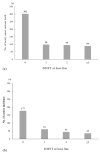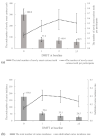Majority of New Onset of Dental Caries Occurred from Caries-Free Students: A Longitudinal Study in Primary School Students
- PMID: 33207679
- PMCID: PMC7698044
- DOI: 10.3390/ijerph17228476
Majority of New Onset of Dental Caries Occurred from Caries-Free Students: A Longitudinal Study in Primary School Students
Abstract
We examined Rose's axiom that a large number of people exposed to a small risk may generate more cases than a small number exposed to a high risk, using data on caries incidence. This longitudinal study was based on the records of annual dental checks conducted in primary schools in Okinawa, Japan. Participants were students aged 6-11 years at baseline in 2014, and a follow-up survey was conducted after one-year. The outcome variable was the increased number of decayed, missing, and filled teeth (DMFT). The predictor variable was the baseline DMFT score. Gender, grade, and affiliated school variables were adjusted. A negative binomial regression model was used to obtain the estimated increase of DMFT score. Among 1542 students, 1138 (73.8%) were caries-free at baseline. A total of 317 (20.6%) developed new caries during the follow-up. The predicted number of new carious teeth in a caries-free students and students with DMFT = 1 at baseline were 0.26 (95% CI, 0.22-0.31) and 0.45 teeth (95% CI, 0.33-0.56), respectively. However, among the total of 502 newly onset of carious teeth, 300 teeth (59.7%) occurred from the caries-free students at baseline. Hence, prevention strategies should target the low-risk group because they comprise the majority of the population.
Keywords: dental caries; longitudinal study; population approach; prevention paradox; universal health coverage.
Conflict of interest statement
The authors declare no conflict of interest.
Figures



Similar articles
-
The impact of a school-based tooth-brushing program on dental caries: a cross-sectional study.Environ Health Prev Med. 2019 Dec 30;24(1):83. doi: 10.1186/s12199-019-0832-6. Environ Health Prev Med. 2019. PMID: 31888460 Free PMC article.
-
Caries trajectories from childhood to adolescence: Analysis of data from a nationwide school dental service.Community Dent Oral Epidemiol. 2024 Dec;52(6):900-910. doi: 10.1111/cdoe.12996. Epub 2024 Jul 23. Community Dent Oral Epidemiol. 2024. PMID: 39042574
-
[Dental health in German and Turkish school children--a 10-year comparison].Gesundheitswesen. 2007 Feb;69(2):105-9. doi: 10.1055/s-2007-970149. Gesundheitswesen. 2007. PMID: 17405082 German.
-
New Method of Avoiding Underestimation of Caries Incidence and Its Association with Possible Risk Factors in Japanese University Students: A Prospective Cohort Study.Int J Environ Res Public Health. 2022 Feb 21;19(4):2490. doi: 10.3390/ijerph19042490. Int J Environ Res Public Health. 2022. PMID: 35206677 Free PMC article.
-
Comparison of linear and zero-inflated negative binomial regression models for appraisal of risk factors associated with dental caries.J Indian Soc Pedod Prev Dent. 2016 Jan-Mar;34(1):71-5. doi: 10.4103/0970-4388.175521. J Indian Soc Pedod Prev Dent. 2016. PMID: 26838152 Review.
Cited by
-
Prevalence of Dental Caries in Schoolchildren from the Galapagos Islands: ESSO-Gal Cohort Report.Int J Dent. 2023 Dec 11;2023:6544949. doi: 10.1155/2023/6544949. eCollection 2023. Int J Dent. 2023. PMID: 38111753 Free PMC article.
-
Early Childhood Caries in a Preschool-based Sample in Northeast Italy: Socioeconomic Status and Behavioral Risk Factors.Int J Clin Pediatr Dent. 2022 Nov-Dec;15(6):717-723. doi: 10.5005/jp-journals-10005-2469. Int J Clin Pediatr Dent. 2022. PMID: 36866145 Free PMC article.
-
Factors Affecting Future Caries Occurrence Among Preschoolers in Northern Guangdong: A Longitudinal Study.Clin Epidemiol. 2021 May 25;13:345-355. doi: 10.2147/CLEP.S312132. eCollection 2021. Clin Epidemiol. 2021. PMID: 34079377 Free PMC article.
References
-
- Vos T., Abajobir A.A., Abate K.H., Abbafati C., Abbas K.M., Abd-Allah F., Abdulkader R.S., Abdulle A.M., Abebo T.A., Abera S.F., et al. Global, regional, and national incidence, prevalence, and years lived with disability for 328 diseases and injuries for 195 countries, 1990–2016: A systematic analysis for the Global Burden of Disease Study 2016. Lancet. 2017;390:1211–1259. doi: 10.1016/S0140-6736(17)32154-2. - DOI - PMC - PubMed
-
- Kassebaum N.J., Smith A.G.C., Bernabe E., Fleming T.D., Reynolds A.E., Vos T., Murray C.J.L., Marcenes W. Global, Regional, and National Prevalence, Incidence, and Disability-Adjusted Life Years for Oral Conditions for 195 Countries, 1990–2015: A Systematic Analysis for the Global Burden of Diseases, Injuries, and Risk Factors. J. Dent. Res. 2017;96:380–387. doi: 10.1177/0022034517693566. - DOI - PMC - PubMed
Publication types
MeSH terms
LinkOut - more resources
Full Text Sources
Medical

